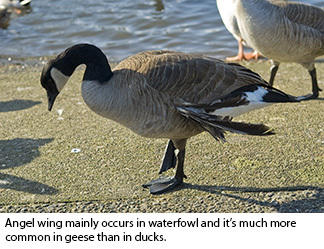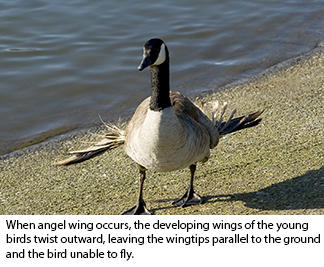Angel Wing
 It’s a nice sunny day, so you head to the park. You watch as a family scatters bread and popcorn for the ducks and geese and the birds swim over to eat the handouts. The children squeal with delight, the parents smile and the ducks and geese enjoy an easy meal. It seems an idyllic scene with all parties going away happy. But it’s not so innocent as it seems. There is a hidden problem in this story. Despite the family’s good intentions, they are unknowingly endangering the health of the ducks and geese, so eager to take the handouts offered. Human-fed waterfowl are put at risk of developing a condition known as “angel wing.” You have probably seen birds with this condition without knowing the cause. The tips of their wings point outward, away from the body as if broken, and these birds cannot fly.
It’s a nice sunny day, so you head to the park. You watch as a family scatters bread and popcorn for the ducks and geese and the birds swim over to eat the handouts. The children squeal with delight, the parents smile and the ducks and geese enjoy an easy meal. It seems an idyllic scene with all parties going away happy. But it’s not so innocent as it seems. There is a hidden problem in this story. Despite the family’s good intentions, they are unknowingly endangering the health of the ducks and geese, so eager to take the handouts offered. Human-fed waterfowl are put at risk of developing a condition known as “angel wing.” You have probably seen birds with this condition without knowing the cause. The tips of their wings point outward, away from the body as if broken, and these birds cannot fly.
Angel wing affects geese, and to a lesser extent, ducks and swans, but does not occur in wild populations. It is found only where people feed birds, mostly in parks where waterfowl congregate. If you care about the birds’ health, don’t feed them; just enjoy watching them.
Much is unknown about angel wing, but it only occurs as young birds are growing. A diet high in carbohydrates and protein is the problem and this is precisely what some human foods (popcorn, bread, etc.) contain. Large amounts of these foods raise the birds’ sugar and protein levels and decrease levels of manganese and vitamins D and E. The imbalance of these dietary constituents causes the feathers of young birds to grow too fast. Thus, the weight of the feathers in the wings becomes greater than the birds’ developing wrist bones can support and the bones twist outward. As the bones grow and solidify, the wings’ twisted position becomes permanent, condemning the bird to a flightless existence. Both wings are often affected, but sometimes only the left wing is twisted. For reasons we don’t understand, rarely is only the right wing affected. By not feeding the birds foods unnatural to them, angel wing can be completely prevented.
 Additional problems can be created by feeding ducks and geese in parks. The birds quickly lose their fear of humans and geese, especially, can sometimes become aggressive in an attempt to obtain food from you. This may be intimidating for adults and, although not common, geese can cause injury to young children. On warm summer days children love to wade along the shallow edges of the ponds in parks. When a lot of people feed the waterfowl, it raises the nutrient level in the water and increases the growth of bacteria, algae, and protozoans in the water.. While most of these are safe, some are not and children with bare feet can get small cuts where these organisms can enter. It is much safer for the birds and the human visitors to not feed the waterfowl at all. Cracked corn is safer than bread by decreasing the chance of angel wing but can still increase nutrients in the water and promote the growth of bacteria.
Additional problems can be created by feeding ducks and geese in parks. The birds quickly lose their fear of humans and geese, especially, can sometimes become aggressive in an attempt to obtain food from you. This may be intimidating for adults and, although not common, geese can cause injury to young children. On warm summer days children love to wade along the shallow edges of the ponds in parks. When a lot of people feed the waterfowl, it raises the nutrient level in the water and increases the growth of bacteria, algae, and protozoans in the water.. While most of these are safe, some are not and children with bare feet can get small cuts where these organisms can enter. It is much safer for the birds and the human visitors to not feed the waterfowl at all. Cracked corn is safer than bread by decreasing the chance of angel wing but can still increase nutrients in the water and promote the growth of bacteria.
If feeding geese and ducks at the park is sometimes harmful, what about feeding birds in our back yards? In your yard, the situation is quite different than feeding popcorn and bread to ducks and geese. In the park, the young, rapidly-growing birds are put at risk but in yards, most birds at feeders are adults, or fully-fledged birds whose wings are formed. The seed in your feeders will not be fed to young birds in nests since most songbirds feed only insects to their young. Seeds sold as bird feed are either natural, or similar in properties, to seeds the birds eat in the wild, and angel wing is not known to occur in songbirds.
There are many misconceptions about feeding birds. If you have heard that birds may not migrate if you don’t take down your feeders, be assured that this is completely false. In migratory birds, the urge to migrate is too strong to be overcome by the presence of feeders, and food we supply accounts for only a small portion of any bird’s diet. There are some risks to feeding birds in your yard, but these are minimal and preventable with a little effort on your part and none will results in angel wing.
What are these risks? Some bacterial and fungal diseases can easily be spread among birds congregating at feeding stations. But, you can prevent this by keeping feeders clean and free from debris. If you see any sign of mold on your feeders or the ground, clean it away immediately. Feeders can be cleaned with a weak bleach solution, but if you do this, be certain to completely rinse away all traces of bleach or detergent residues. Given Oregon’s wet winters, it is advisable to cover feeders so that the seed cannot get wet, causing mold to grow on the feeder or seeds. At Wild Birds Unlimited you will find variety of domes are available that work well for this purpose.
Feeding birds can bring much pleasure but we need to do it in a manner that causes no harm to the birds. Only a small effort is needed to do so. In your yard, a bird feeder is a wonderful way to see birds but away from home, enjoy observing the birds but please don’t bring bread, popcorn or other human food to feed waterfowl in our parks. It is not a kindness to feed birds when doing so can jeopardize their health or potentially cause deformities such as angel wing.

